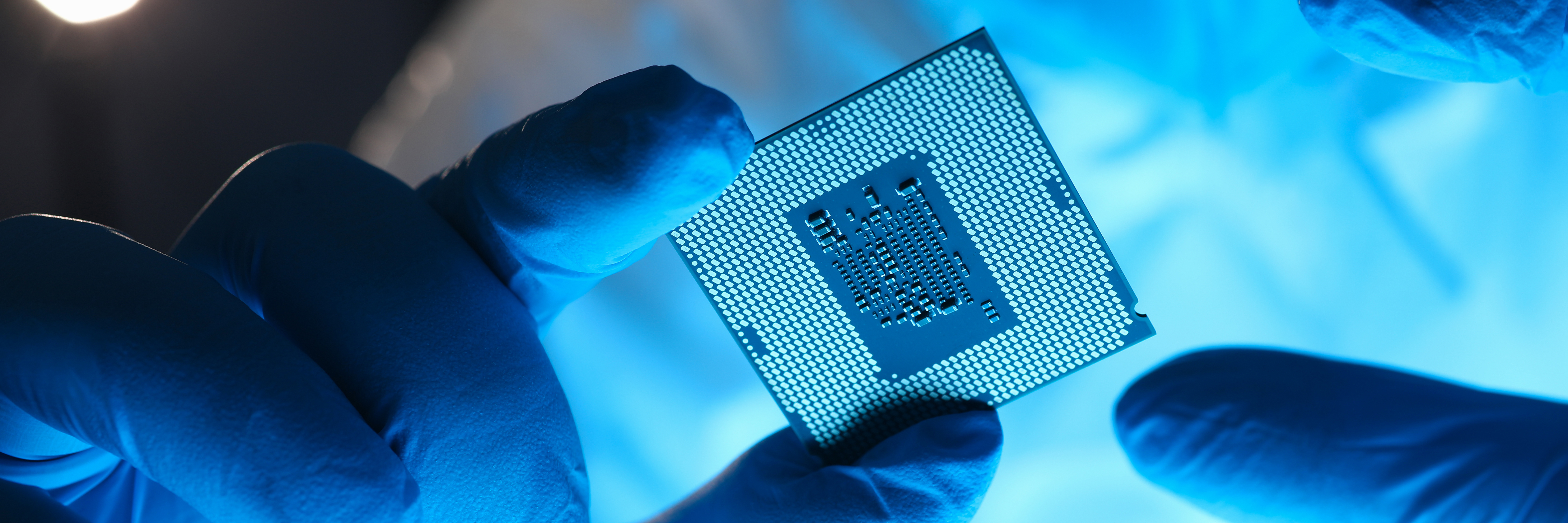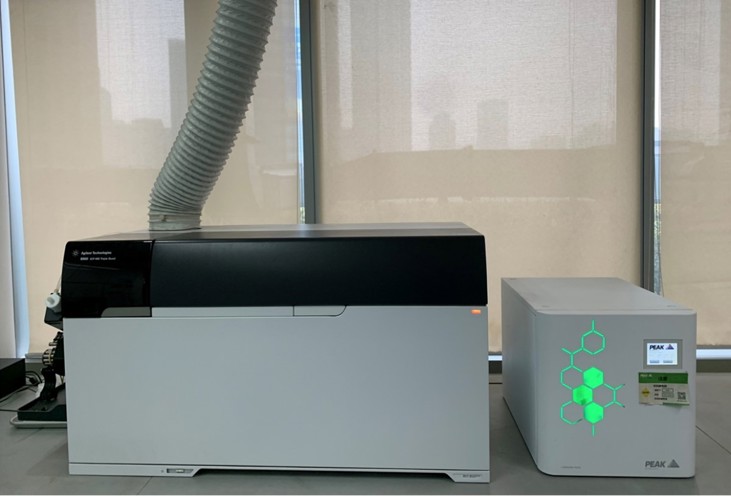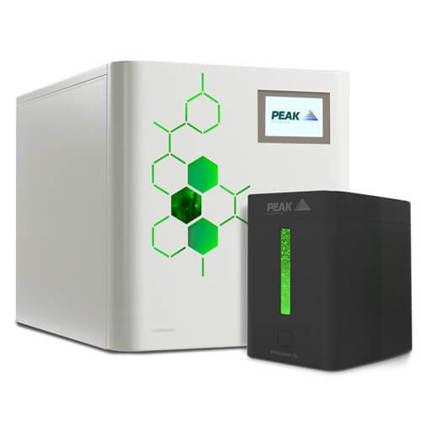Hydrogen as Reaction Gas—ICP-MS analysis for the semiconductor industry
In the semiconductor industry, contaminants, which can be introduced into each step of the production process can cause defects in semiconductor devices.
A variety of chemicals, such as hydrogen peroxide (H2O2), hydrochloric acid (HCl), and sulfuric acid (H2SO4) are used throughout the manufacturing process of semiconductor devices for cleaning and etching.
- Hydrogen peroxide (H2O2) acts as a strong oxidant and can be used to clean silicon wafers and remove photoresists (thick resin mixtures).
- Mixtures of nitric acid (HNO3) and hydrofluoric acid (HF) are used to etch monocrystalline silicon and polysilicon.
- A mixture of sulfuric acid (H2SO4) and hydrogen peroxide (H2O2) can be used for cleaning wafer processing.
Hydrochloric acid (HCl) reacts with most metals to form water-soluble salts that remove impurities such as organic and metal residues from the surface of silicon wafers used in semiconductor production.

What to consider as semiconductor performance improves
As the performance of semiconductor devices continues to improve, the control requirements for impurities are also more stringent, and trace amounts of impurities in the chemicals used affect the performance and yield of the final product. The International Semiconductor Equipment and Materials Industry Association (SEMI) has published a standard for the performance indicators of high-purity reagents, stipulating that the content of the vast majority of impurity elements must not exceed 10 ppt.
Therefore, when manufacturing semiconductor devices, it is necessary to routinely monitor trace contaminants in the chemicals used in the process of cleaning and etching silicon wafers. Trace contamination must be controlled to the lowest concentration as much as possible; a commonly used monitoring tool for this is ICP-MS.
Interference from plasma, solvents and matrices of polyatomic ions during the test can lead to elevated background signals, overlapping mass spectra, and difficulty in measuring when some lighter elements are at trace levels.
How can collision cells solve background disturbance?
This background disturbance can be solved using methods such as cryogenic plasma and collision/reaction cells. Collision/reaction cells developed for ICP-MS can remove specific interferences through chemical reactions, which helps to remove some analytical challenges. In reaction cells, hydrogen (H2) and oxygen (O2) are often used as reaction gases. Analytes or interferences react and combine with the reaction gas in the reaction cell to form a compound with a different mass number, which avoids interference with the target analyte.
For example:
Determination of silicon in H2 in situ mass mode: 14N2+ and 12C16O+, which interfere with the main Si isotopes at m/z 28, react easily with H2, but Si+ does not react with H2. As a result, N2+ and CO+ interferences are removed by the reaction with H2allowing 28Si+ to be measured without interference:
28Si+ + H2 <pool gas> = No response
14N2+ + H2 <pool gas> = N2H+ + H
12C16O+ + H2 <pool gas> = COH+ + H
Determination of chlorine Cl in H2 mass transfer mode: 16O18O1H+ produces polyatomic interference with the primary Cl isotope at m/z 35. This O2H+ overlapping interference can be effectively removed by measuring ClH2+, a product of the Cl hydrogenation reaction. As shown in the figure below, Cl reacts continuously with the H2 reaction gas to generate product ions:
35CL+ + H2 <pool gas> = 35Cl1H+ + H
Then, 35Cl1H+ = H2 <pool gas> = 35Cl1H2+ + H
16O18O1H+ + H2 <pool gas> = no response
How can hydrogen be supplied to the ICP-MS?
The hydrogen in the reaction cell can be supplied by a hydrogen generator.

Agilent Shanghai Laboratory - 8900 ICP-MS Triple Quad and PEAK Precision Trace Hydrogen Generator
At Agilent's Shanghai laboratory, a PEAK Precision Trace hydrogen generator provides hydrogen to meet the requirements for the 8900 ICP-MS Triple Quad reaction cell, which has been working in the laboratory for many years.
PEAK’s Precision Trace Hydrogen Generator is small and compact, saving valuable laboratory space, with a high-value "minimalist" design and a green accent that echoes the PEAK brand's emphasis on environmental protection - providing a reliable source of hydrogen for the lab while reducing carbon emissions.
PEAK’s Precision series of hydrogen generators are designed for laboratory applications, combining convenience and reliability into stackable, modular and compact designs. Hydrogen is produced on site through electrolyzed water, according to the lab's demands, providing hydrogen with a purity of up to 99.9999% and a flow rate of 100-1200cc/min. Precision Trace series hydrogen generators use Pressure Swing Adsorption and other technologies to effectively remove moisture and ensure the purity and quality of hydrogen. Compared to cylinders, gas generators are a safer, more reliable and more convenient gas supply solution.

What are the advantages of a gas generator?
An important advantage of using a hydrogen gas generator is safety and convenience. An on-site hydrogen generator can produce hydrogen on demand to suit your laboratory requirements and is ready at the press of a button. Unlike lab’s using gas cylinders, a lab with a PEAK hydrogen generator will experience less downtime due to the removal of the need for cylinder changes.
A gas generator from PEAK is a great alternative to gas cylinders for many reasons, but one of the most crucial is the safety of lab personnel. Gas cylinders store large amounts of high pressure gas and, if this is released into the lab, can have serious implications.
A hydrogen generator, on the other hand, is able to supply hydrogen to a number of applications without the need for high-pressure gas stored on site. In terms of hydrogen safety, PEAK’s generators have a number of built in safety functions such as internal leak test on start-up, over pressure alarm, and external hydrogen leak detector. These built in safety functions keep your lab safe by automatically stopping the generator if a hydrogen leak occurs.
Content Reference
Agilent ICP-MS Application Paper: Measuring Inorganic Impurities in Semiconductor Manufacturing
Agilent Application Note: Direct analysis of trace metal impurities in high purity hydrochloric acid with 7700s/7900 ICP-MS
Agilent Application Note: Direct analysis of trace metal impurities in high purity nitric acid using ICP-MS/MS
Agilent Application Note: Direct measurement of metal impurities in 20% ammonium hydroxide with 7700s/7900 ICP-MS